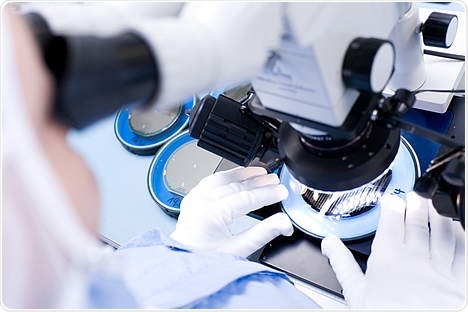In association with Stanford University, a working group from the Division of Cell and Developmental Biology at the Medical University of Vienna (MedUni Vienna) has discovered the role of a crucial factor that plays a role in early embryonic development.

Image Credit: Medical University of Vienna.
This factor is called the Zscan4 protein, which has currently been demonstrated to safeguard the early embryo from the breakdown of DNA strands and also from DNA damage during the stimulation of the first of its genes.
To date, it was not known why the Zscan4 protein is highly expressed during what is known as the embryonic genome activation—that is, when the genome of the embryo is stimulated for the first time—and the kind of function it plays.
In our study, we were able to identify a mechanism that evolution has set up to protect the early embryo from lethal DNA damage during times of high genomic stress.”
Mark Wossidlo, Epigeneticist and Embryologist, Division of Cell and Developmental Biology, Medical University of Vienna
With the help of an animal model, Wossidlo initiated this study when he was working as a post-doc at Stanford University in the United States and has presently finished it in association with Joanna Wysocka’s working group at MedUni Vienna.
“If in these very early stages of life, in the first few hours or days, the early embryo is unable to activate its genes safely, there cannot be any life,” added Wossidlo.
Important protection during the stressful phase of early embryos
The background: Zygote—the fertilized oocyte—is a specialized cell from which, all other types of cells needed to produce a new life can form. Such a capacity is called “totipotency.”
Also, this totipotency is retrieved following the first division in the subsequent stage of development—that is, the two-cell stage. On the other hand, the cells of the later embryo in the blastocyst happen to be “merely” pluripotent and can form several types of cells but not all.
In the mouse model, embryonic genome activation occurs in this totipotent two-cell stage, where the two-cell embryo turns into a multi-cell blastocyst in a few days with the involvement of its embryonic genes.
Shortly after fertilisation, thousands of embryonic genes are simultaneously activated for the first time. During this process, the DNA in the cells comes under huge stress, which can result in unstable DNA folding and even lethal DNA damage.”
Mark Wossidlo, Epigeneticist and Embryologist, Division of Cell and Developmental Biology, Medical University of Vienna
The Zscan4 protein prevents this damage by docking onto so-called microsatellites (repetitive short, uncoded DNA sequences) and ensuring the protection of the genome and its long-term stability when the embryonic genome is activated.
This is achieved by preventing the formation of zigzag-shaped Z-DNA, as this is highly susceptible to breaks in the DNA strand and could result in genetic instability.
In the lab, the researchers showed that the Zscan4 protein binds particularly to these microsatellites, thus safeguarding them from the formation of a Z-DNA structure.
Moreover, they demonstrated that the elimination of Zscan4 at the time of embryonic genome activation leads to precisely this type of lethal genetic damage in the two-cell embryo.
Thus, we have identified another important mechanism that increases our understanding of the mechanisms that help to ensure successful development of a new living being in the very early stage of life.”
Mark Wossidlo, Epigeneticist and Embryologist, Division of Cell and Developmental Biology, Medical University of Vienna
The overall goal of this fundamental research working group at MedUni Vienna is to identify the processes involved in “reprogramming” the germ cells of life soon after fertilization to turn into “all-rounders” and the effects of faulty reprogramming on future generations.
The main focus of the group is on the role of epigenetics, or the inheritable modification of the DNA, which can influence gene activity without modifying the DNA sequence.